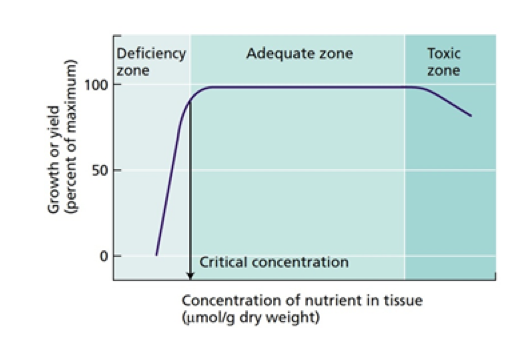Diagnosing Nutrient Deficiency in Cannabis Plants
By Grace Lin
AEssense Applications Scientist
Healthy cannabis plants produce high yields. To produce heathy plants, healthy cuttings (or seeds), optimum environment (day/night temperature, relative humidity, CO2, light intensity, photoperiod), good air circulation, ventilation, clean water, and proper nutrient management should all be considered and designed carefully. Plants do not thrive if any of the conditions are missing.
As we described in “Plant nutrition”, there are about 18 mineral nutrients that plants need in their life cycle. In an optimum environment, the yields of most crop plants increase linearly with the amount of essential nutrients they absorb. The relationship between yield and nutrient content of the plant tissue defines zones of deficiency, adequacy, and toxicity (yes, too much nutrients do become toxic for plants!) (Figure 1).

Figure 1. Relationship between plant yield (or growth) and the nutrient content of the plant tissue
Note that yield increases exponentially at the beginning and stops after reaching the critical concentration of nutrient in plant tissue. There is a large adequate zone before reaching the toxic zone, where additional nutrients no longer contribute to the increase of yield. While it might be difficult to observe plants under this zone without any toxicity symptoms showing on the plants, growers continue to waste nutrients by by applying additional plant nutrients.
In an ideal world, we want to add just enough nutrients right pass the critical concentration that plants show no nutrient deficiency symptoms. However, it is a difficult task in the real world because it involves many variables including plant variety, plant mature stage, and the environment factors. Managing the best nutrient concentration is a continuous process and often requires much trial and error.
To diagnose nutrient deficiency symptoms, we usually separate all the mineral nutrients into two groups depending on its mobility. If the element is mobile, it can move from one part of the plant to another as needed. When there is a nutrient deficiency, we see symptoms on older or lower leaves first because the plant will transport the elements to support its younger tissue.
If the element is immobile, younger leaves or new tissues will show the deficiency symptoms first because the elements will remain in the older tissues.
The elements that are mobile include nitrogen (N), phosphorus (P), potassium (K), magnesium (Mg), molybdenum (Mo) and nickel (Ni).
The elements that are immobile are sulfur (S), calcium (Ca), iron (Fe), manganese (Mn), zinc (Zn), boron (B) and copper (Cu).
Macronutrients (N, P, K, Ca, Mg, and S) are the elements that plants use the most, and therefore are the nutrients most often found deficient. Other micronutrients (Fe, Mn, Cu, Zn, and B) also cause abnormal growth that are relatively easy to observe.
Nitrogen (N) deficiency: yellowing of the leaves start showing in the older leaves near the base of the plants. If the condition persists, these leaves become completely yellow and fall off the plants.
Phosphorus (P) deficiency: different from nitrogen deficiency, phosphorus deficiency does not turn the leaves into yellow color. On the contrary, leaves turn dark green and even purple color from the margins. The petioles also turn red-purplish color.
Potassium (K) deficiency: leaves margins and tips turn yellow and rusty and may also curl and crinkle from the older leaves. Stem branches may increase and plants become slender and weak.
Calcium (Ca) deficiency: yellow-brown irregular spots start developing on young leave margins. Young leaves may also appear curled and deformed.
Magnesium (Mg) deficiency: a classic magnesium deficiency symptom is leaves yellowing between the veins, while the veins remain green. Irregular yellow-brown spots may appear on older leaves, and eventually lower leaves curl and drop.
Sulfur (S) deficiency: young leaves turn yellow and plants become short and small. Similar to nitrogen deficiency but starts with the younger leaves.
Boron (B) deficiency: yellow-brown necrosis spots show between leaf veins on younger leaves and terminal buds. New stems and growing shoots grow abnormally and burned. Leaves may become thick and brittle.
Iron (Fe) deficiency: leaves yellowing between the veins start with younger leaves. Very similar to magnesium deficiency, but iron deficiency (being an immobile element) starts with young leaves and magnesium deficiency starts with older leaves.
Copper (Cu) deficiency: young leaves become twisted and deformed. Leaf tips and margins become dark green and contain necrotic spots.
Manganese (Mn) deficiency: a typical deficiency symptom is yellowing between the veins with the development of small necrotic spots. It is relatively uncommon for cannabis plants.
Zinc (Zn) deficiency: new shoots and young leaves become very small and clustered. Yellowing between veins start from the tips and margins of the young leaves. Internode spacing (the length between two nodes on the stem) become short and restricted.
Before diagnosing nutrient deficiency, it is critical to first check the pH of the growth media (soil, coco…) and the water solution. The pH of the nutrient solution plays a key role in nutrient availability. When the pH of the solution is out of the correct range, the plant roots cannot absorb nutrients even with all the nutrient elements present in the water. The wrong pH range typically associates with certain nutrient deficiencies and checking the pH first will help us to diagnose the nutrient problem. For more information about water pH and nutrient management, please take a look at “Water EC and pH”.
Also be aware that some plant pests or environmental stress can also cause similar symptoms, so it’s important to always consider the overall environment condition. Are the temperatures within the right range? Are there flying bugs around that might feed on the plants? Without an optimum environment, plants cannot be healthy even when there is a lot of food.
A summary of nutrient deficiency symptoms:
AEssenseGrows Fresh Produce (Fresh Vegetables & Leafy Greens)